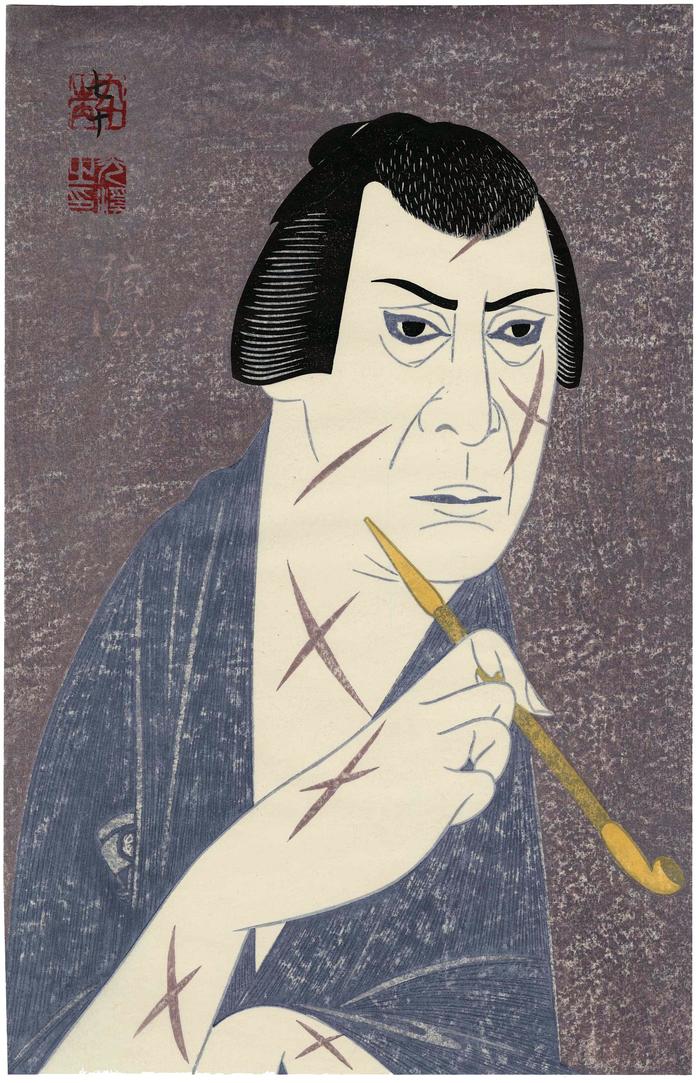Tsuruya Kōkei (弦屋光溪) (artist 1946)
Onoe Kikugurō VII (より七世尾上菊五郎) as Kirare Yosaburō (切られ与三郎) from the play Yowa Nasake Ukina no Yokogushi (与話情浮名横櫛)
05/1990
Japanese woodblock print
Artist Seal: Seal of Kōkei (光溪之印)
Edition Seal: Out of 90 (九十之内) with brushed-in number “90” (shichiju 七十) at upper left over top seal
Tsuruya Kokei web site
Muscarelle Museum of Art in Williamsburg, Virginia
Pacific Asia Museum, Pasadena
National Museum of Asian Art The National Theater of Japan described this character: "Izuya Yosaburo is the young master of a merchant family in Edo (modern-day Tokyo). He falls in love with Otomi, the mistress of a gang boss, on the beach at Kisarazu. This gets out, and his body is slashed in 34 places, including between his eyebrows, on his left cheek, and under his right eye; he gains the nickname Kirare Yosa (“Scarred Yosa”). Coincidently, he once again meets Otomi in a house he has visited to blackmail, and reproaches her, saying, “Shiganee koi no nasake ga ada...(The love for you that I could not help was my enemy...)” This role was created by Yoshimura Isaburo IV, a master of nagauta (a song performed in time to shamisen music), based on a true story that he had experienced in his youth."
****
Performed at the Kabuki-za, Tokyo, January 1990; Series: Daihachi ki ōkubi-e shirīzu sono ni (Bust Portraits VIII, Design 2: 第八期大首絵シリーズの2)
Gray mica ground; printed on extremely thin gampi tori no ko paper (from Fukui Prefecture); blocks cut on Tilia Japonica (plywood with lime wood surface); printed to edges of paper (no margins); with purple mica ground.
****
Roger Keyes in his doctoral thesis, 'Courage and Silence: A Study of the Life and Color Woodblock Prints of Tsukioka Yoshitoshi: 1839-1892', wrote on page 236 about the diptych of Yosaburō and Yasu: "In the Kabuki version of this story, Izuya Yosaburō was an extremely handsome man who fell in love with Otomi, a geisha who had become the mistress of a gang leader. When their affair was discovered, Otomi escaped, flung herself into the sea, and was presumed drowned. Yosaburō was tortured and his face mutilated by the gang leader in revenge. In the years that followed, Yosaburō became a blackmailer and a petty thief. Unbeknownst to him, Otomi had been saved from drowning by a man whom she did not recognize as her brother and had been taken to the Genyadana district of Edo to live innocently with him. Yosaburō's confederate Yasu, called The Bat because of a tattoo on his cheek, met Otomi and guessed some scandal that he and Yosaburō could profit from. The two approached the gateway to the district at night, and Yasu pointed out the house to Yosaburō, whose face was covered to conceal his scars. Later the lovers recognized one another, but, before they could be reunited, Yosaburō was captured by the police and sent into exile."
self-printed (sōsaku hanga - 創作版画) (genre)
Onoe Kikugorō VII (七代目尾上菊五郎: October 1973 to present) (actor)
